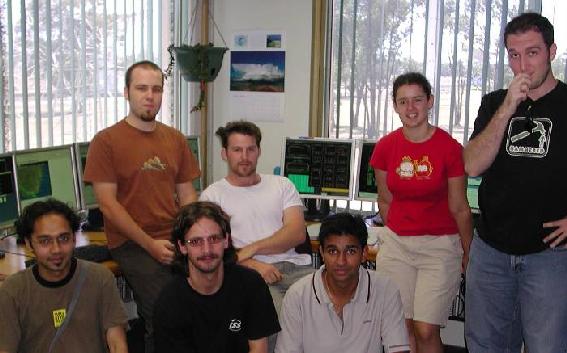ATNF outreach
Summer vacation program
For the 2004/2005 summer vacation program the ATNF received almost 200 applications and accepted six students. This was the first time that the ATNF program did not involve other CSIRO Divisions or other Australian institutions. A consequence of the smaller group was that the students quickly got to know each other and formed a strong group. Four of the students were based in Sydney, and two at the Parkes Observatory. The students arrived in early December and spent 10 weeks working on a broad range of research projects, described in the report below. They also spent several days at the Compact Array where 36 hours of observing time was allocated for three group projects. The Narrabri observations were ably supported by Juergen Ott. The program ended with a half-day symposium where the students presented excellent talks on their research and the observatory trip.
Jessica Chapman and Naomi McClure Griffiths
(Jessica.Chapman@csiro.au , Naomi.McClure-Griffiths@csiro.au)
Planet Earth is pretty much home
Scientists, physicists, engineers, computer programmers and a teacher — the 2004/2005 summer vacation students were a mixed bunch of early 20-year-olds with a wide range of backgrounds, skills and aspirations.
We all applied for the summer program for something interesting to do and were certainly not disappointed. However, we had varying aspirations. Nadia wanted to play with a telescope; Joris was looking for an entry into real astronomy after completing his masters in radio astronomy in Sweden; Jamil was keen to network. I believe the Narrabri snake was not a contact Jamil expected or hoped for, but it certainly capped off a memorable week.
Over the course of the summer program I asked my peers "why are you here; what are you doing?" After receiving many blank expressions, I rephrased my philosophical questions of creation and existence and discovered a little bit about the various projects we were working on.

Figure 1: ATNF 2004/2005 summer vacation students. Back row: Peter Hansen, Nadia Davidson, Jamil Zaman, Joris Verbiest. Front row: Michael Klinkert, Ruchir Gupta. Photocredit: Shaun Amy
Jamil worked on high speed data transfer from telescopes around the world to a common correlator in CSIRO; apparently "speed is essential in this". From flagging unreliable data to improving image quality Joris came to know UGCA 438, an irregular dwarf galaxy. His intimate knowledge of UGCA 438 enabled Joris to calculate the total mass of HI present and examine phenomena such as galactic rotation and its dark matter content. Nadia worked on software development for the virtual observatory project, specifically looking at converting coordinate, time, frequency etc. from one reference frame, or coordinate system, into another. Nadia used the current aips++ service module and produced an interactive web interface. Peter examined the impact that recent surface upgrades to the Parkes radio telescope have had on wind loading. The effect of wind loading on the Parkes radio telescope is vital to the continuing usage of the Parkes research facility. Ruchir focussed on Fourier transforms while characterising pulsar timing noise. I produced school and teacher information packages specifically designed to inform teachers of exactly what is at the Parkes visitors centre. I also created numerous directed learning activities for students visiting the Dish and post-visit classroom material.
The future for us is also diverse. Jamil will complete his studies at Melbourne University and plans to visit "home" in Bangladesh at some stage. Joris enjoyed his summer so much he has chosen to pursue his PhD in Australia despite previous studies in Sweden, Norway and Belgium. Nadia plans to complete honours in particle physics in Melbourne. Peter will find out soon if he is successful in gaining a PhD scholarship with CSIRO and QCAT. Ruchir will complete his studies in Sydney. I have already begun teaching high school Maths and Science in Canberra.
On behalf of the 2004/2005 summer vacation students, I would like to thank everyone at ATNF for the opportunity, new friendships and a stack of memories.
Michael Klinkert
(klinkertmichael@yahoo.com.au)
